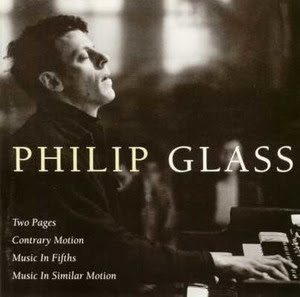
Philip Glass's (b. January 31, 1937, Baltimore, Maryland) music is frequently described as minimalist, though he has distanced himself from that description, calling himself a composer of "music with repetitive structures."
Although his earliest definitive music could be called minimalist, his style has evolved enough that the label is inappropriate for many of his more recent works.
Glass counts many visual artists, writers, musicians, and directors among his friends, including Richard Serra, Chuck Close, Doris Lessing, Allen Ginsberg, Errol Morris, Robert Wilson, JoAnne Akalaitis, John Moran, Godfrey Reggio, Ravi Shankar, Linda Ronstadt, David Bowie, Dennis Russell Davies, and Aphex Twin, who have all collaborated with him. Among recent collaborators are Glass' fellow New Yorkers Leonard Cohen, and Woody Allen.
He has four children: two (Juliet, b. 1968 and Zachary, b. 1971) with his first wife, the theater director JoAnne Akalaitis (m. 1965, div. 1980); and two (Marlowe and Cameron) with his current, fourth wife, Holly Critchlow.
Glass lives in New York and in Nova Scotia.
He was born the grandson of Jewish immigrants from Lithuania. His father owned a record store, and consequently Glass's record collection included music of Bela Bartok, Ludwig van Beethoven (string quartets), Paul Hindemith, Arnold Schoenberg, Franz Schubert (the Piano Trio in B-Flat Major as a "big influence"), and Dmitri Shostakovich -- at a very early age.
Glass studied the flute as a child at the Peabody Conservatory of Music and entered an accelerated college program at the University of Chicago at the age of 15, where he studied mathematics and philosophy. In Chicago he discovered the serialism of Webern and composed a 12-tone string trio.
The young musician then went on to the Juilliard School of Music where the keyboard became his main instrument, and his composition teachers included Vincent Persichetti and William Bergsma. During this time, in 1959, he was a winner in the BMI Foundation's BMI Student Composer Awards. In the summer of 1960, he was taught by Darius Milhaud and composed a Violin Concerto for a fellow student, Dorothy Pixley-Rothschild.
Next was Paris, where he studied with the eminent composition teacher Nadia Boulanger from 1963 to 1965, analyzing scores of Johann Sebastian Bach (The Well-Tempered Clavier), Wolfgang Amadeus Mozart (piano concertos), and Beethoven. Glass later stated in his autobiography Music by Philip Glass (1987) that the new music performed at Pierre Boulez's Domaine Musical concerts in Paris lacked any excitement for him (with the notable exceptions of music by John Cage and Morton Feldman), but he was deeply impressed by performances of new plays at Jean-Louis Barrault's Odéon theatre and the revolutionary films of the French New Wave, such as those of Jean-Luc Godard and François Truffaut, which ignored the rules set by an older generation of artists.
After working with Ravi Shankar in France on a film score (Chappaqua), Glass traveled to northern India in 1966, where he came in contact with Tibetan refugees and began to gravitate towards Buddhism.
Glass's distinctive style arose from his work with Shankar and his perception of rhythm in Indian music as being entirely additive. When he returned home he renounced all his compositions in a moderately modern style resembling Milhaud, Aaron Copland, and Samuel Barber, and began writing pieces based on repetitive structures and a sense of time influenced by Samuel Beckett, whose work he encountered when he was writing for experimental theater.

The first of the early pieces in this minimalist idiom was the music for a production of Samuel Beckett's

Play (1963) in 1965 for two soprano saxophones; another was String Quartet No.1 (1966).
Finding little sympathy from traditional performers and performance spaces, Glass eventually formed an ensemble in New York City in the late 1960's with fellow ex-students Steve Reich, Jon Gibson, and others and began performing mainly in art galleries.
The first concert of Philip Glass's new music was at Jonas Mekas's Film-Makers Cinemathèque (Anthology Film Archives) in 1968. This concert included Music in the Shape of a Square for two flutes (an homage to Erik Satie, performed by Glass and Gibson) and Strung Out for amplified solo violin (performed by the violinist Pixley-Rothschild). The musical scores were tacked on the wall, and the performers had to move while playing. Glass's new works met with a very enthusiastic response by the open-minded audience that consisted mainly of visual and performance artists who were highly sympathetic to Glass's reductive approach.
Apart from his music career, he worked as a cab driver, had a moving company with Steve Reich, and worked as an assistant for the sculptor Richard Serra. During this time he made friends with other New-York-based artists such as Sol LeWitt, Nancy Graves, Laurie Anderson, and Chuck Close. After certain differences of opinion with Steve Reich, Glass formed the Philip Glass Ensemble (while Reich formed Steve Reich and Musicians), an amplified ensemble including keyboards, wind instruments (saxophones, flutes), and soprano voices.

[Phil, Chuck Close, 1969]
At first his works continued to be rigorously minimalist, diatonic and repetitively structured, such as
Two Pages,
Contrary Motion,
or Music in Fifths
(a kind of homage to his composition teacher Nadia Boulanger, who pointed out "hidden fifths" in his works but regarded them as cardinal sins). Eventually Glass's music grew less austere, becoming more complex and dramatic, with pieces such as
Music in Similar Motion (1969) and
Music with Changing Parts (1970).
Glass's work for theater from this time - apart from his works for the Philip Glass Ensemble and music theater - included many compositions for the group Mabou Mines, which he co-founded in 1970.
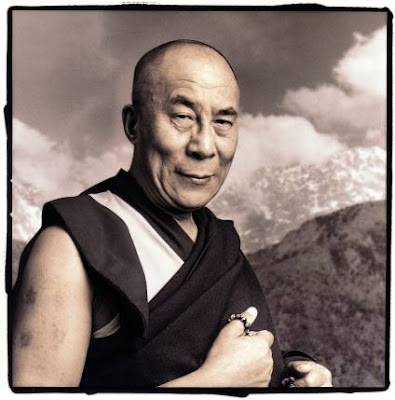
He met Tenzin Gyatso, the 14th Dalai Lama, in 1972, and has been a strong supporter of the Tibetan cause ever since.
Glass's instrumental series of early minimalist works culminated in the four-hour-long
Music in Twelve Parts (1974),
which began as a sole piece in 12 instrumental parts but developed into a cycle that summed up Glass's musical achievement since 1967, and even transcended it: the last part features a 12-tone theme, sung by the soprano voice of the ensemble. Though he finds the term minimalist inaccurate to describe his later work, Glass does accept this term for pieces up to and including Music in 12 Parts.
Glass continued with Another Look at Harmony (1975).
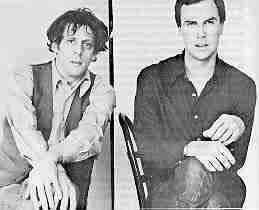
[Philip Glass and Robert Wilson, by Robert Mapplethorpe]
He collaborated with Robert Wilson on what he later designated as the first opera of his portrait opera trilogy: Einstein on the Beach (composed in 1975 and first performed in 1976), featuring his ensemble, solo violin, chorus, and actors. The piece was praised by the Washington Post as "one of the seminal artworks of the century."
***
Einstein on the Beach:
KNEE PLAY 1
Act I, Scene 1 TRAIN
Act I, Scene 2 TRIAL
Act IV, Scene 1 SPACESHIP
Act IV, Scene 2 BED
***
Glass's theatre work included further music for plays or adaptations from the prose by Samuel Beckett, such as The Lost Ones (1975) and Cascando (1975).
***
Music With Roots in the Aether: Opera for Television. Tape 2: Philip Glass. Produced and directed by Robert Ashley. New York, New York: Lovely Music (1975)
North Star (1977)
Mercier and Camier (1979, after Samuel Beckett)
Fourth Series (1979)
Dance (a collaboration with choreographer Lucinda Childs and the visual artist Sol Lewitt, 1979).
Mad Rush (1979, dedicated to the Dalai Lama)
***
Glass's Satyagraha (1980), on the early life of Mahatma Gandhi and his experiences in South Africa, was another turning point for Glass, as his first piece scored for symphony orchestra after about 15 years, even if the most prominent parts were still reserved for solo voices (now operatic) and chorus.
***
Satyagraha
Act I, Scene 1
Act I, Scene 3
Act III, Part 3
***
Glass has, since the 80's, written works more accessible to ensembles such as the string quartet and symphony orchestra, in this returning to the structural roots of his student days. In taking this direction his chamber and orchestral works were also written in a more and more traditional and lyrical vein. Glass often employs old musical forms, such as the chaconne, in Satyagraha later works.
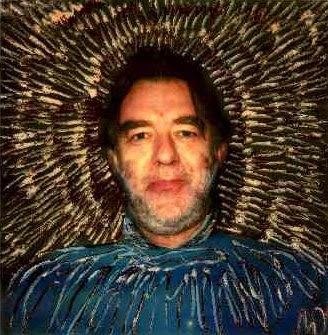
Glass has composed many film scores, which almost accidentally started with the orchestral score for Koyaanisqatsi (Godfrey Reggio, 1982).
***
Philip Glass. From Four American Composers. Directed by Peter Greenaway (1983)
***
The Portrait Trilogy was completed with Akhnaten (1984), a powerful vocal and orchestral composition sung in Akkadian, Biblical Hebrew, and Ancient Egyptian. In addition, this opera featured an actor reciting ancient Egyptian texts in the language of the audience. Akhnaten was commissioned by the Stuttgart Opera in a production designed by Achim Freyer. It premiered simultaneously at the Houston Opera in a production designed by Peter Sellars. At the time of the commission, the Stuttgart Opera House was undergoing renovation, necessitating the use of a nearby playhouse with a smaller orchestra pit. Upon learning this, Glass and conductor Dennis Russell Davies visited the playhouse, placing music stands around the pit to determine how many players the pit could accommodate. The two found that they could not fit a full orchestra in the pit. Glass decided to eliminate the violins, which had the effect of "giving the orchestra a low, dark sound that came to characterize the piece and suited the subject very well."
***
Akhnaten
Act I, Scene 1 Funeral of Amenhotep III
Act II, Scene 2 Akhnaten and Nefertiti
***
In the same year, Glass again collaborated with Robert Wilson on another opera, the CIVIL warS, which also functioned as the final part - the Rome section, of Wilson's epic work by the same name, originally planned for an "international arts festival that would accompany the Olympic Games in Los Angeles." The premiere in Los Angeles never materialized and the opera was in the end premiered at the Opera of Rome, and included texts by Seneca and allusions to the music of Giuseppe Verdi and music from the American Civil War, featuring the 19th century figures Giuseppe Garibaldi and Robert E. Lee as characters.
Other productions included music for Endgame (1984), and Company (1984). Beckett approved of the Mabou Mines production The Lost Ones, but vehemently disapproved of the production of Endgame at the American Repertory Theatre (Cambridge, Massachusetts), which featured Joanne Akalaitis's direction and Glass's Prelude for timpani and double bass. In the end, though, he authorized the music for Company, four short, intimate pieces for string quartet that were played in the intervals of the dramatization. This piece was eventually published as String Quartet No. 2 and as a concert piece for string orchestra.
The film score to Mishima: A Life in Four Chapters (Paul Schrader, 1985) resulted in the String Quartet No.3.
***
A Composer's Notes: Philip Glass and the Making of an Opera [Akhnaten]. Directed by Michael Blackwood. Michael Blackwood Productions (1985). Re-released, on DVD, in 2005.
***
Songs from Liquid Days (1986, CBS Records) is a collection of songs with lyrics by Paul Simon, Suzanne Vega, David Byrne and Laurie Anderson. Glass began the project scoring lyrics by Byrne and then thought to collaborate with additional songwriters.
On the project, Glass said: "The words come first. From these I fashioned a set of six songs which, together, form a cycle of themes ranging from reflections on nature to classic romantic settings. After the music was written, I — along with producer Kurt Munkacsi and conductor Michael Riesman— began the long and difficult process of 'casting' singers for the individual songs. We felt that the interpretation a singer brings to a song is an immense contribution to its character — contributing their own personality to the work perhaps more than any other performer."
The recording features performances by Bernard Fowler, Kronos Quartet, Janice Pendarvis, Douglas Perry, The Roches, Linda Ronstadt, and the Philip Glass Ensemble, directed by Michael Riesman.
The album's song Lightning was performed by the Philip Glass Ensemble on Saturday Night Live, March 22, 1986.
***
Einstein on the Beach: The Changing Image of Opera. Directed by Mark Obenhaus (1986)
***
Glass is "a Jewish-Taoist-Hindu-Toltec-Buddhist", and a strong supporter of the Tibetan cause. In 1987 he co-founded the Tibet House with Columbia University professor Robert Thurman and the actor Richard Gere.
Encouraged largely by conductor Dennis Russell Davies to pursue concert music, Glass has written eight concertos to date, beginning with the almost neo-baroque 3-movment chaconne-utilizing Violin Concerto (1987). This piece was written in the memory of Glass's father: "His favorite form was the violin concerto, and so I grew up listening to the Mendelssohn, the Paganini, the Brahms concertos. . . . So when I decided to write a violin concerto, I wanted to write one that my father would have liked." Among its multiple recordings, in 1992, the Concerto was performed and recorded by Gidon Kremer and the Vienna Philharmonic Orchestra.
The turn to orchestral music was continued with a large-scale symphonic Trilogy (The Light, The Canyon, Itaipu, 1987–1989) and The Voyage, commissioned by the Metropolitan Opera.
Glass has written more works for solo piano, including a cycle of five pieces for a theatrical adaptation of Franz Kafka's The Metamorphosis (1988). The critic John Rockwell dismissed the work (as well as all others since Akhnaten) as "simplistic."
***
Witchita Sutra Vortex (1988, written for the poet Allen Ginsberg)
***
In 1988, Glass began a collaboration with the filmmaker Errol Morris with his score for Morris's celebrated documentary The Thin Blue Line.
The composer continued the Qatsi trilogy with the score for Powaqqatsi (Reggio, 1988).
Central to his chamber music from the same time are a series of five string quartets that were written for the Kronos Quartet (1989 and 1991), and Music from The Screens (1989, with Gambian kora player Foday Musa Suso), and In the Summer House (1993), in collaboration with
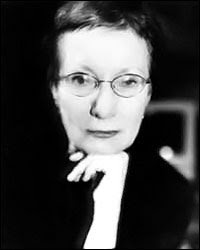
director Joanne Akalaitis, Glass's first wife. The Screens is, on occasion, a touring piece for Glass and Suso. Apart from Suso's influence, the musical texture is remotely evocative to classical European chamber music ranging from Bach to French chamber music by Claude Debussy and Maurice Ravel.
***
Music from "The Screens": In the Court of the Mad Cadi (with Foday Musa Suso)
Passages: Prashanti (with Ravi Shankar)
Candyman (Bernard Rose, 1992)
Concerto Grosso (1992)
***
Early admirers included musicians Brian Eno and David Bowie, who acknowledged the influence of Glass's minimalist style. Glass, who became friends with Bowie, composed certain pieces from themes of Bowie and Eno's collaborative albums beginning with Low (originally written in Berlin in the late 1970), in his three-movement Symphony No. 1 ("Low") (1992).
***
Symphony No. 1 ("Low"): I. Subterraneans
***
Glass's prolific output continued to include operas, especially a second opera, triptych (1993–1996), based on the work of Jean Cocteau, his prose and films (Orphée (1949), La Belle et la Bête (1946), and the novel Les Enfants Terribles, 1929, later made into a film by Cocteau and Jean-Pierre Melville, 1950). In the same way it is also a musical homage to the work of a French group of composers associated with Cocteau, Les Six.
Apart from this influence, Les Enfants Terribles (1996, scored for voices and three pianos), is indebted in its writing for the piano ensemble to a musical key work from the 18th century: Bach's Concerto for Four Harpsichords (or four pianos) in A minor, BWV1065 (based on a concerto by Vivaldi). Not coincidentally, Bach's Concerto was used in the score of Melville's film.
In the first part of the trilogy, Orphée (1993), the inspiration can be (conceptually and musically) traced to Gluck's opera Orfeo ed Euridice (Orphée et Euridyce, 1774)[ which had a prominent part in Cocteau's 1949 film. One theme of the opera, the death of Eurydice, has some similarity to the composer's personal life: the opera was composed about a year after the unexpected death in 1991 of Glass's wife, artist Candy Jernigan.
The opera's "transparency of texture, a subtlety of instrumental color" was praised, and The Guardian 's critic remarked "Glass has a real affinity for the French text and sets the words eloquently, underpinning them with delicately patterned instrumental textures."
Glass described Symphony No. 2 (1994) as a study in polytonality and referred to the music of Honegger, Milhaud, and Villa-Lobos as possible models, but the gloomy, brooding, dissonant tone often alludes to Dmitri Shostakovich as well.
***
Candyman: Farewell to the Flesh (Bill Condon, 1995)
Saxophone Quartet Concerto (1995)
***
Glass continuing his keyboard writing with the first volume of Etudes for Piano (1995). The first six were originally commissioned by the conductor and pianist Dennis Russell Davies, but the complete first set is now often performed by Glass. Rockwell has praised the music as "powerful," comparing the etudes to Bartók's oeuvre for piano. Most of the Etudes are composed in the post-minimalist/more expressive style of the Symphony No. 2 and No. 3, and Saxophone Quartet Concert.
Symphony No.3 (1995), commissioned by the Stuttgart Chamber Orchestra, a more transparent, refined, and intimate chamber-orchestral style resurfaced after the excursions of his large-scale symphonic pieces (mirroring similar developments in the work of his contemporary and colleague Steve Reich).
In its four movements, Glass treats a 19-piece string orchestra as an extended chamber ensemble, and seems to evoke early classical music, as well as the neo-classical music of Igor Stravinsky and Béla Bartók. In particular, the second movement is much freer than anything else before in Glass's output since 1966, whereas in the third, Glass re-uses the chaconne as a formal device, creating haunting string textures.
In 1995 he composed the theme for Reggio's short independent film Evidence.
***
The Secret Agent (1996, film adaptation of Joseph Conrad)
Symphony No. 4 ("Heroes") (1996)
The Marriages of Zones 3, 4, and 5 (libretto by Doris Lessing after her novel, 1997)
Glass received his first Academy Award nomination for Kundun (Martin Scorsese, 1997), about the Dalai Lama.
***
Songs of Milarepa (1997)
***
Glass even made a cameo appearance in Peter Weir's The Truman Show (1998), which uses music from Powaqqatsi, Anima Mundi, and Mishima, as well as three original tracks by Glass, performing at the piano.
In 1999, he finished a new soundtrack for the 1931 film Dracula.
***
Symphony No.5 ("Choral") (1999)
***
Glass has returned to the form frequently since the year 2000. His Tirol Concerto for Piano and Orchestra (2000) was premiere by Dennis Russell Davies as conductor and soloist
***
Concerto Fantasy for Two Timpanists and Orchestra (2000)
***
His Concerto for Cello and Orchestra (2001) was premiered in Beijing by the cellist Julian Lloyd Webber, for whose 50th birthday it was written.
Symphony No.6 ("Plutonian Ode") (2001), commissioned by the Brucknerhaus Linz and Carnegie Hall in honor of Glass's 65th birthday, started as a collaboration with the poet Allen Ginsberg (for reciter and piano -- Ginsberg and Glass), based on his poem by the same title.
***
Concerto for Harpsichord and Orchestra (2002)
Naqoyqatsi (2002, film by Godfrey Reggio')
***
In 2002, Glass along with his longtime producer Kurt Munkacsi and artist Don Christensen, started the record label Orange Mountain Music, dedicated to "establishing the recording legacy of Philip Glass" and have to date released 40 albums of Philip Glass' music.
The Hours (Stephen Daldry, 2002), which earned him a second Academy Award nomination;
***
The Sound of a Voice (2003, adds the chinese Pipa to its classical chamber opera)
***
The Fog of War (Errol Morris, 2003) and Taking Lives (D. J. Caruso, 2004); and are Glass's most notable scores for films from the early 2000's, containing older works but also newly composed music.
***
Symphony No.7 ("Toltec") (2004)
***
The second movement of Piano Concerto No. 2 ("After Lewis and Clark") (2004), composed for the pianist Paul Barnes, features the Native American flute.
***
Orion (2004)
Secret Window (David Koepp, 2004)
A Musical Portrait of Chuck Close (2005, dedicated to the visual artist)
Waiting for the Barbarians (after J.M. Coetzee's novel by the same name, with a libretto by Christopher Hampton), was premiered in September 2005. I n this work Glass "used very simple means and the orchestration is very clear and very traditional; it's almost classical in sound," as the conductor Dennis Russell Davies described it.
Two months later, in November 2005, Glass's Symphony No.8, commissioned by the Bruckner Orchester Linz, was premiered at the Brooklyn Academy of Music in New York City. It features extended solo writing (not unlike Béla Bartók's Concerto for Orchestra). Critic Allan Kozinn described the symphony's chromaticism as more extreme, more fluid, and its themes and textures as continually changing, morphing without repetition, and he especially pointed out the "unpredictable orchestration" of the symphony.
These new orchestral textures also surfaced in the orchestral scores for the films The Illusionist and Notes on a Scandal, both composed in 2006. The latter garnered his third Academy Award nomination.
His Passion of Ramakrishna (2006), was composed for the Orange County's Pacific Symphony Orchestra, the Pacific Chorale and the conductor Carl St. Clair.
Songs and Poems for Solo Cello, a Cello Suite in seven movements from the same year, was composed for Glass's girlfriend, the cellist Wendy Sutter, and was described by Lisa Hirsch as "a major work, . . . a major addition to the cello repertory" and "deeply Romantic in spirit, and at the same time deeply Baroque." Another critic, Anne Midgette of the Washington Post, noted that the suite "maintains an unusual degree of directness and warmth"; she also noted (as Hirsch) a kinship to a major work by Johann Sebastian Bach: "Digging into the lower registers of the instrument, it takes flight in handfuls of notes, now gentle, now impassioned, variously evoking the minor-mode keening of klezmer music and the interior meditations of Bach's cello suites".
Glass has also worked alongside Leonard Cohen on an adaptation of Cohen's poetry collection Book of Longing. The work, which premiered in June, 2007, in Toronto, Canada, is a piece for seven instruments and a vocal quartet, and contains recorded spoken word performances by Cohen and imagery from his collection.
Glass's newest film scores include Scott Hicks's No Reservations, Woody Allen's Cassandra's Dream, and Laurent Charbonnier's documentary Les Animaux Amoureux (Animals in Love), all from 2007.
***
GLASS: A Portrait of Philip in Twelve Parts. Directed by Scott Hicks (2007)
***
Appomattox, Glass's most recent opera, surrounding the events at the end of the American Civil War, and commissioned by the San Francisco Opera was premiered on October 5, 2007. As Waiting for the Barbarians and Symphony No.8, the piece was conducted by Glass's long time collaborator Russell Davies, who noted that "in his recent operas the bass line has taken on an increasing prominence,(...) (an) increasing use of melodic elements in the deep register, in the contrabass, the contrabassoon - he's increasingly using these sounds and these textures can be derived from using these instruments in different combinations. (...) He's definitely developed more skill as an orchestrator, in his ability to conceive melodies and harmonic structures for specific instrumental groups. (...) what he gives them to play is very organic and idiomatic."
Most recently, Glass provided an "hypnotic" original score for compilation Samuel Beckett's short plays Act Without Words I, Act Without Words II, Rough for Theatre I, and Eh Joe, directed by JoAnne Akalaitis and premiered in December 2007. Glass' work for this production was described by the New York Times as "icy, repetitive music that comes closest to piercing the heart."
Glass continues his work with Akalaitis with his choral music to Euripides's The Bacchae (2008).
Among new works in various stages of completion are the Symphony No.9 and No.10, and a large-scale opera on the life of Johannes Kepler (to be premiered by Dennis Russell Davies, 2009).
Philip Glass is acknowledged to be one of the most influential voices of the 20th Century.
A great number of composers including Danny Elfman, Mark Alburger, and Erling Wold have credited him with influencing the sound of the 2nd half of the 20th Century and beyond.
Glass has also influenced Mike Oldfield and bands including Tangerine Dream, Phish, and Talking Heads.
 [Figured Bass / Realization
[Figured Bass / RealizationGlass - Einstein on the Beach: BED]
***

The Everly Brothers (Don and Phil, born Isaac Donald Everly, February 1, 1937, and Phillip Everly, January 19, 1939) are country-influenced rock and roll performers, known for steel-string guitar playing and close harmony singing.
Don and Phil Everly are both guitarists and use a simple vocal harmony mostly based on parallel thirds. With this, each line can often stand on its own as a melody line.
For virtually all the Everly Brothers recordings, Don sings the lower harmony part, while Phil takes the higher part. One rare exception is on Devoted To You. Although Don is still low and Phil is high, they switch singing the lead and harmony back and forth. As well, Don almost always sings any lines that are sung solo (for example, the verses of Bye Bye Love, 1957). Among the very few exceptions to this rule is the Everlys' 1965 single It's All Over, where Phil sings the song's solo lines.
The duo's harmony singing had a strong influence on rock and roll groups of the 1960's. The Beatles, The Beach Boys, and Simon & Garfunkel developed their early singing styles by performing Everly covers.

http://www.youtube.com/watch?v=vFoIdxLBm_A
[8938 Corigliano / 8937 Glass / 8936 Reich]
